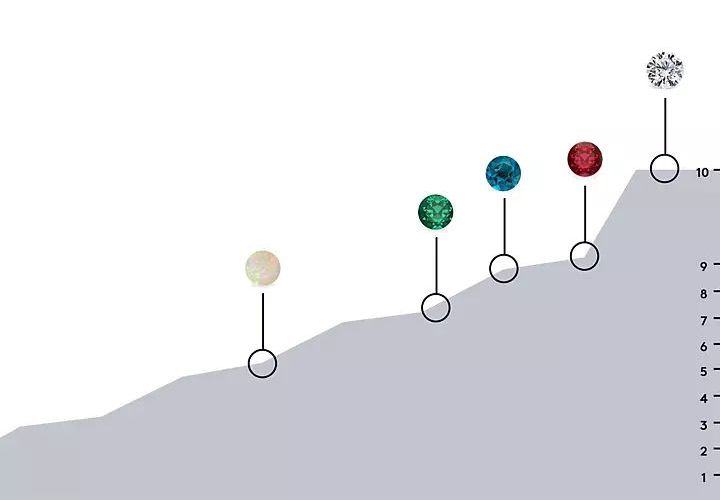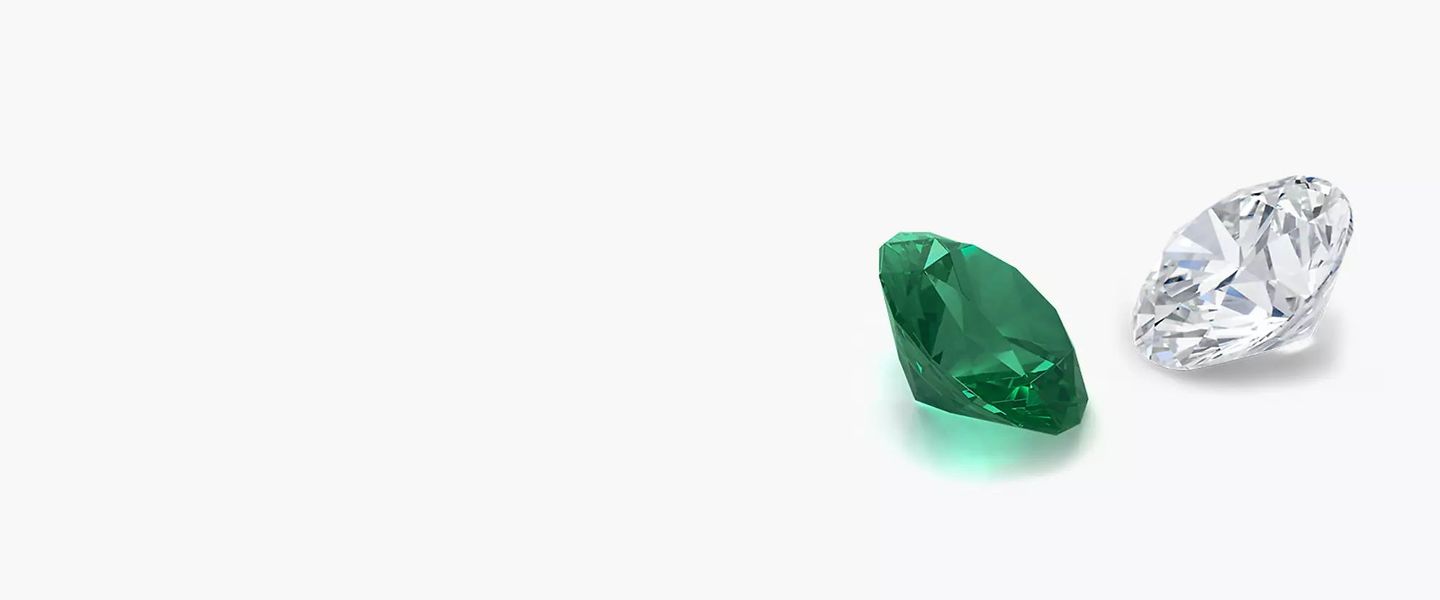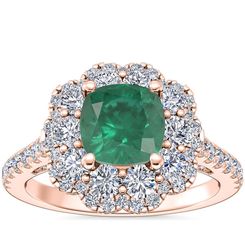Origins and Rarity
Diamonds were first mined more than 2,400 years ago in India. Now, diamonds are both found naturally and created in labs. Natural diamonds form when carbon atoms are exposed to intense heat and pressure deep in the mantle of the earth, causing them to crystallize.
Diamonds are not the rarest gemstone, but their clarity, color, carat and cut combine to make them truly exceptional and deeply treasured.
Natural emeralds are much rarer than diamonds. The mesmerizing green stones are found mostly in South America, with the majority of emeralds coming from Colombia. Emeralds can also be created in a lab, resulting in stones that are often clearer than a natural emerald.
Appearance
From the different ways they glisten, to the colors of the stones and the elements of their clarity, emeralds and diamonds are quite different.
Sparkle
Diamonds are famous for their sparkle and fire, as they refract light into a shimmering rainbow of hues.
Emeralds, on the other hand, don’t reflect the light as much as diamonds do. Instead, they look luminous as the light hits them and creates flashes of captivating green tones.
Color
The color of a gemstone is, perhaps, its most striking quality. Diamonds are renowned for their brilliant clear look, but there are many color options to choose from, including green diamonds. These tend to boast a more translucent green tone that promises the classic diamond sparkle along with a dazzling color.
Emeralds are always green, but these vibrant gems exhibit a wide range of shades within this color family. An emerald’s color is described using three categories, tonal grade, hue and saturation.
Tonal grade refers to how light or dark green the emerald is, and can range from Very Light to Very Dark, with higher quality emeralds usually in the darker tones. The hue describes what kind of green coloring the emerald possesses, such as a yellowish-green or bluish-green. The saturation describes the intensity of the color of the gem.
Clarity
A gemstone’s clarity is a key point to consider when buying fine jewelry. Diamond clarity is officially graded using the Gemological Institute of America’s clarity scale, which ranges from Flawless to Included. Most diamonds fall into the SI, Slightly Included, or VS, Very Slightly Included categories, meaning most inclusions are only visible under 10x magnification.
Almost all emeralds have inclusions, including gas bubbles and minerals that were trapped during the gem’s formation and fissures that occurred naturally while it was being formed. In fact, inclusions are part of an emerald’s allure. An emerald’s one-of-a-kind inclusions are called its jardin, French for garden, and its clarity can range from softly cloudy to almost clear.
HARDNESS & WEARABILITY
Diamonds claim an untouchable status as the hardest substance in the world, making them an ideal option for everyday wear as an engagement ring. They score 10 on the Mohs Scale and are impossible to scratch, except by another diamond.
Emeralds are much softer gems, scoring a 7.5 to 8 on the Mohs scale. They are durable enough for everyday wear, but care should be taken to avoid scratching or chipping. When selecting an emerald for everyday wear, stones with few or no surface-reaching inclusions are best, as they are more resistant against chipping.

Enhancements
A range of gemstone enhancement options can enhance the clarity or color of a diamond. Heat treatments, high-pressure, high-temperature (HPHT) treatments, irradiation and coatings are techniques that can give a diamond a new color or intensify its natural one. Fracture filling to minimize the appearance of white fractures can improve the appearance of a diamond’s clarity. Laser drilling allows imperfections to be removed.
It is typical for natural emeralds to be treated with an oil or resin to keep the appearance of their jardin beautifully subtle and emphasize their rich green coloring. This also helps to make the stones more durable and resistant to chipping.
Meanings and Symbolism
Diamonds have been a classic choice for engagement rings due to their ubiquitous symbolism of everlasting love and faithfulness. Because of their status as the hardest substance on earth, diamonds also symbolize power. Purity is often associated with colorless diamonds.
All gemstones have special meaning, and emeralds have a personal and romantic symbolism. They’re said to help the wearer visualize the future and are associated with truthful relationships and deep intuition.
Shop Popular Emerald Engagement Rings
Popular Ring Styles and Settings
Diamonds offer an exquisite array of cuts, with each one possessing its own personality and emphasizing certain aspects of the stone. The round cut is an enduring favorite, since it highlights the sparkle of a diamond, but other choices abound.
Settings are also a highly personalized choice for diamonds. Whether you prefer an elegant solitaire setting or wish to accent your stone with shimmering pavé or a halo of stones, diamonds are endlessly versatile and combine effortlessly with other stones, allowing you freedom to design.
Perhaps the most classic cut for an emerald is the one named after it! The emerald cut is a chic rectangular cut that suits the natural shape of the gem. Because emeralds are more sought after for their color rather than sparkle, this cut is ideal because it features a large surface that highlights the color and inner beauty. It is also a very stable cut that helps maximize the strength of this softer gem.
Emeralds are also available in a wide variety of other cuts, including a brilliant cut to maximize the sparkle, and a mixed cut that blends elements of the brilliant and emerald cuts for a look that accentuates both color and sparkle.
Because the emerald is a softer gem, a bezel setting or halo setting can be an excellent choice that showcases the gem while giving it extra protection.
Blue Nile Promise
Whether you’re in love with the idea of an emerald’s bold hue, the scintillating sparkle of a diamond or you’re still curious about other gemstone options, we’re here to help. We’re ready to guide you through the process with expert information and services to help you find the right engagement ring to express your love.
We offer a range of complimentary services, including ring sizing, to make sure that the fit is as perfect as the style, and you can count on our excellent services, including free returns to ensure that you are delighted with your ring. Our complimentary cleaning services let you keep your ring looking as breathtaking as the day you bought it.













